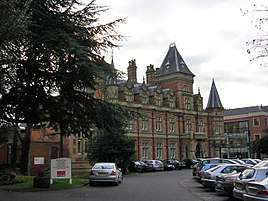Mary Corner
Mary Corner (25 March 1899 – 4 November 1962), was a pharmacist, a worker in the British Cotton Industry and British Leather Manufacturers, Head of the Micro-analytical Section of the Chemical Research Laboratory, Vice-Chairman of the Microchemistry group and a founding member of the Microchemical Club.
Mary Corner | |
|---|---|
| Born | 1899 |
| Died | 4 November 1962 (aged 62–63) |
| Nationality | British |
| Occupation | Chemist |
| Known for | She was a founding member of the Microchemical Club. |
Early life and education
Mary Corner was educated at Beulah House High School, Balham, London.[1] As a child, Corner had an "unfortunate accident" and "burdened with a severe disability, and she had, in addition, more than the usual share of suffering and trouble."[1]
Career

During the First World War, Mary worked in a pharmacy, entering Battersea Polytechnic a forerunner of the University of Surrey, in 1922 and graduating in 1927.[1]
She obtained a position with the British Cotton Industry Research Association in Didsbury, Manchester, in 1928,[1] working initially in the rayon department where she developed a fascination with microanalysis[1] which resulted in a promotion to Head of the Microanalytical Section.[1] Then, in 1945, she obtained a similar post with the British Leather Manufacturers' Research Association.[1]
Two years later, Corner was invited to become Head of the newly formed Microanalytical Section of the Chemical Research Laboratory (later the National Chemical Laboratory).[1]
In the 1930s, she became a founder member of the Microchemical Club (to be later joined by Isabel Hadfield).[1]
In 1953, she was elected an Ordinary Member of the Council for the Society of Public Analysts and Analytical Chemists.[2]
Death
At the time of her death on 4 November 1962, she was Vice Chairmen of the Microchemistry Group of the Society for Analytical Chemistry.[1]
References
- Rayner-Canham, Marelene F.; Rayner-Canham, Geoffrey (2008). Chemistry Was Their Life: Pioneering British Women Chemists, 1880-1949. Imperial College Press. ISBN 9781860949876.
- "Proceedings of the Society of Public Analysts and other Analytical Chemists". Analyst. 78 (926). 1953-01-01. Bibcode:1953Ana....78..262.. doi:10.1039/AN9537800262. ISSN 1364-5528.